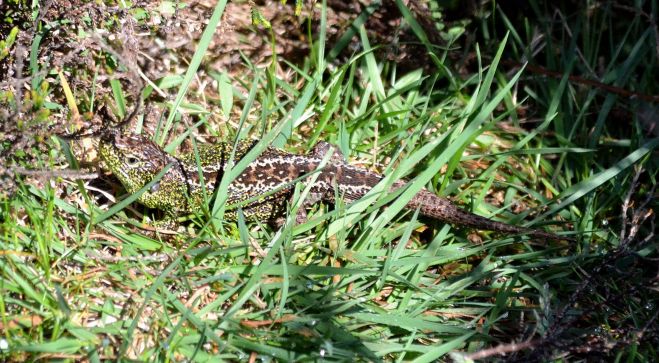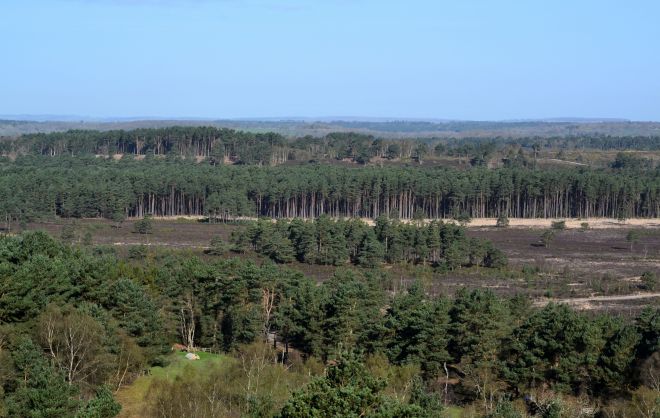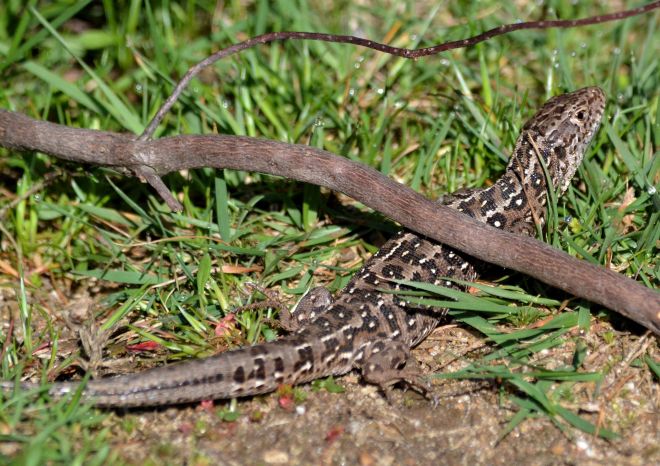Gaining the grassy and not terribly sharp image below has involved a lot of hard work. In recent weeks I have invested more time and energy to self-finding Britain’s rarest lizard than I can ever remember devoting to any bird or insect. But Sand Lizards are not easy creatures to track down or take pictures of. After three days this week searching sites on the Surrey heaths, following on from two earlier days reconnoitring, I was eventually successful this morning and all that effort was well worth it in the end.

Male Sand Lizard
I have a great liking for all reptiles and observing the scarce heathland specialists Sand Lizard and Smooth Snake has been a long held ambition. My first attempt three years ago on the Dorset heaths resulted in abject failure. Put off by the difficulty of finding such tiny needles in the haystacks of huge expanses of habitat, I have looked in vain for organised walks in the two springs since then. But alas, the Wildlife Trusts like all conservation organisations now seem interested only in the family audience rather than catering for serious wildlife enthusiasts.
Locating an experienced guide to assist me in this quest has proved equally fruitless. But this year one source gave me the valuable advice that Sand Lizard are best located as the day warms up, and to avoid searching during the hottest part of the day. That narrow window of opportunity serves to complicate the logistics of a trip to Dorset, and so after consulting Amphibian and Reptile Conservation’s on-line site guide (see here) I switched my attention to the Surrey Heaths instead.

Frensham Common
ARC lists various locations in Surrey and Hampshire where it has re-introduced and manages habitat for Sand Lizard and Smooth Snake. Some of them also have indigenous populations and that whet my interest still further. Due to wider habitat loss these species now only occur naturally on such managed heathland sites. As Sand Lizards require mature sunny habitats and open undisturbed sand in which to lay their eggs, they can have quite limited distribution even within the protected areas. Eggs are laid in late May or early June and left to incubate in sand exposed to the sun before hatching between late August and September.
On two finer days during the recent wet early spring weather I explored several sites, noting the more compact and hence easier to work ones where reptile habitat appeared to have been created. Then with the prospect of spring weather arriving this week at the peak time for Sand Lizard emergence from hibernation, I booked into local accommodation and resolved to give things a proper go. There’s an old saying that if you want a thing done properly it’s best to do it yourself, and let’s face it I take that option quite a lot.
I needed a new and different project to fire my imagination this spring and self-finding those two rare reptiles had become it. One site stood out amongst all those I surveyed, a hilltop by Frensham Common that is said to hold all six British reptiles and where with luck they might be found basking on a sandstone outcrop at the summit. If Sand Lizard really do sit out to be noticed in this place (above, left) the picture opportunities would be quite special.
My first day on site (17th) was a write-off as the forecast sunny weather had yet to materialise. After spending a couple of hours on the hilltop, I continued to explore other sites in the afternoon, gaining an education on many aspects of Tree Pipit (above right) though with little chance of finding reptiles. But from Wednesday morning (18th) “Heatwave Britain” was set to bask in temperatures upwards of 23º C and the quest was well and truly on.
I arrived on site that day at 08:30 in perfect weather conditions and remained as advised while the day warmed up. But by late morning still no Sand Lizard or any other reptile had been encountered. In the afternoon I moved on to explore two more new sites, getting into some beautiful and evocative landscapes. As when I visited Wishmoor Bottom for the Parrot Crossbills last December, it is difficult to remember one is in the south-east English commuter belt in what seem like these vast tracts of heathland.
Feeling disappointed that my prime location had not produced, on Thursday – the warmest April day for 69 years – I tried other previously reconnoitred sites instead. Dog walkers confirmed that reptiles are indeed present and I did at least begin to notice rather small Viviparous (or Common) Lizard diving for cover. On another part of Frensham Common I also witnessed an Adder going to ground, before ending the day back at the hilltop. What I hadn’t reckoned on was the toll all this foot-stomping was taking on my post-prime body. As I write this piece I remain absolutely shattered. Maybe I am being told to slow down as such ageing carriages are wont to do.
That evening I reflected on how to continue motivating myself in the “new and different” sense that habitually I punish myself with. Regularly occurring European birds are now a diminishing return. I have observed and secured images of every English dragonfly and damselfly, and all but a group of northern butterflies. So then there are Sand Lizard and Smooth Snake, or perhaps newts or Natterjack Toad, all of which seemingly involve such an effort of finding. Or getting the garden right again and collecting new and different plants.
No matter, there was one more opportunity this morning and only one place to consider going back to before heading home. This time I took a chair and sat facing the sandstone outcrop in what is just a lovely spot to be. After an hour nothing had appeared on that back drop save a lot of large and fierce looking red ants and various flies and moths. I got up to walk around and there at last was the week’s first adult lizard (pictured below), spoiling the pose by resting underneath a heather twig.

Female Sand Lizard
I hoped by the size and shape this was a female Sand Lizard, but not having seen one before could not be sure. After taking some pictures I went to retrieve my chair and upon returning an unmistakeable male was basking just out of the heather very close to where the other lizard had been. These are medium-sized, robust and stocky lizards with a rounded head and short legs. Males show striking green flanks that are brighter in the breeding season of late April and May. Both genders are characterised by brown and complexly variable patterns down the back with two strong dorsal stripes. Life stages are identifiable by their ocellated (eyed) markings, the dark blobs with enclosed pale centres.
The circumstances of this sighting were just as I had been led to expect: 10am as the day warmed up, though as seemed realistic these reptiles stayed close to cover rather than venturing out onto the rocks. And so my images are just like all the others I see of Sand Lizard, partially concealed. Oh well it wouldn’t do if this superb place were to find its way onto photographers’ forums. Hence my circumspection as to the precise location.
Eventually the male raised its head as if sniffing the air, then darted back into cover not to reappear. Shortly afterwards my chair toppled over backwards and downhill. I landed in a heap in a tangle of gorse and heather but save for a few scratches and a mildly sprained wrist there were no ill effects other than the growing feeling that perhaps I am getting too old for all this. At any rate the day having now warmed up I took that mishap as the signal to leave and seek the relative safety of my wildlife garden at home.
On the way back downhill a Slow Worm (above, left) was basking to one side of the path, and at the bottom a group of walkers had located another smallish Viviparous Lizard. I suppose I should return here in the weeks ahead to try for better pictures. Next up will also be Smooth Snake. Any tips on how to find them, anyone?
















